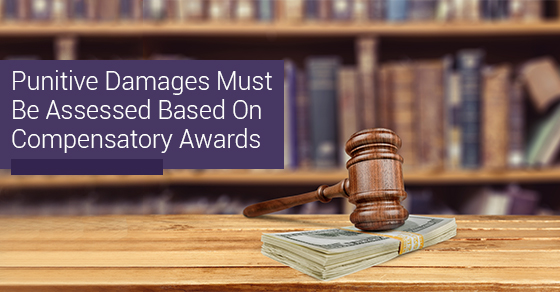Article Content
In a split decision released on November 5, 2013, a majority of the Court of Appeal for Ontario ruled in Pate Estate v. Galway-Cavendish and Harvey (Township), 2013 ONCA 669 that when assessing punitive damage awards, trial judges must look to the total compensation and costs otherwise awarded.
The majority decision, written by Justice Cronk and concurred by Justice Doherty (with Justice Lauwers dissenting), interpreted elements in the seminal Supreme Court decisions of Whiten v. Pilot Insurance Co., 2002 SCC 18, and Hill v. Church of Scientology of Toronto, [1995] 2 SCR 1130, to the effect that compensatory damages actually include a punitive element. Following that reasoning, Cronk J.A. held at paragraph 211 of the majority ruling that trial judges must consider “what amount of punitive damages, taken together with other compensation…, was rationally required to meet the objectives of retribution, deterrence and denunciation”. (Emphasis added) More specifically, she ruled that punitive damages need to be discounted having regard to other punitive elements already imposed through others damages and costs:
[236]….[I]n my view, the quantum of punitive damages to be awarded should have been materially discounted to avoid the risk of an inordinately high award and “double-compensation” to [the plaintiff], having regard to the punitive elements of the penalties already imposed on the Township”. [Citation omitted]
Background Facts
In December 1998, the Township of Galway-Cavendish amalgamated with the Township of Harvey. Until that time, John Pate was the Chief Building Official of the former township for ten years. He became a building inspector in the newly amalgamated township. Shortly afterwards, the amalgamated township terminated Mr. Pate’s employment on the basis of alleged building permits discrepancies. The township had never provided particulars of the allegations. The township’s chief administrative officer told Mr. Pate that if he resigned, the township would not contact the police. Mr. Pate refused to resign. The township terminated Mr. Pate’s employment. It conducted an investigation and turned some information over to the Ontario Provincial Police.
The township had never disclosed to the OPP that it had lost files relating to the alleged discrepancies during the move of the municipal offices, which occurred as part of the amalgamation. In addition, the township had not disclosed to the OPP that a committee of its council had already determined that at least one of the cases involving the alleged discrepancies was without foundation.
The OPP’s investigative officer was reluctant to lay charges. After the township exerted pressure at higher levels of the OPP, charges were laid against Mr. Pate. In 2002, Mr. Pate was acquitted at his criminal trial. The local media reported extensively on the criminal proceedings and on Mr. Pate from the time of his dismissal until his acquittal.
Finding of Misconduct and Damages Originally Awarded
After his acquittal on the criminal charges, Mr. Pate brought an action against the township, seeking damages for wrongful dismissal, malicious prosecution, special damages for his criminal trial defence costs, aggravated damages and punitive damages.
At the original trial (Pate v. Galway-Cavendish (Township), [2009] O.J. No. 5382), the trial judge dismissed the malicious prosecution claim but determined that the township engaged in serious misconduct that was, among other things, “high-handed” and, “reprehensible”. The key findings with respect to the township’s misconduct relate to the nature, duration and impact of the misconduct, as follows:
- the misconduct was of a sustained nature, over a period of ten years;
- the misconduct had a profound and life-changing impact on Mr. Pate, to devastating and permanent effect, and
- despite being a public body, the township had never apologized to Mr. Page for its misconduct.
Mr. Pate was awarded the following damages and costs at the original trial:
- compensation for wrongful dismissal equal to twelve months’ wages, in the amount of $34,000 (this was based on a settlement agreement between the parties on this issue);
- “Wallace damages” (see Wallace v. United Grain Growers Ltd., [1997] 3 SCR 701) as a result of the manner in which the township terminated Mr. Pate’s employment, in an amount equal to four months’ income, totalling $23,413;
- special damages for Mr. Pate’s criminal trial defence costs in the amount of $7,500;
- general and aggravated damages in the amount of $75,000;
- punitive damages in the amount of $25,000;
- costs of the action on a substantial indemnity basis in the total amount of $61,791;
- costs premium of 20% in the amount of $12,358, and
- prejudgment interest.
The total amount for compensation and costs set out above, excluding special damages, punitive damages and prejudgment interest, was $206,662.
Summary of Appeals and Re-Trials
Mr. Pate appealed the decision to the Court of Appeal for Ontario (Pate v. Galway-Cavendish (Township), 2011 ONCA 329) with respect to the dismissal of the malicious prosecution claim and the quantum of punitive damages. The Court of Appeal ordered a new trial on both issues.
The re-trials were held, on the parties’ agreement, separately with respect to the quantum of punitive damages and the malicious prosecution claim. (This was done to allow the township’s leave to appeal to the Supreme Court on the malicious prosecution issue to proceed. The leave application was ultimately dismissed). The re-trials were held before the same trial judge who presided over the original trial. They were based on the record from the original trial and no new evidence was introduced at the re-trials.
On the punitive damage award re-trial (Pate v. Galway-Cavendish and Harvey (Township), 2011 ONSC 6620, [2011] O.J. No. 5318), the trial judge significantly increased the quantum of the punitive damages award from $25,000 to $550,000. This was in addition to all other damages set out earlier. On the malicious prosecution re-trial (Pate (Estate) v. Galway-Cavendish (Township), 2012 ONSC 6740, [2012] O.J. No. 5691), the trial judge found the township liable to Mr. Pate for malicious prosecution. He awarded $1.00 on the parties’ agreement, plus costs of $20,000.
The township appealed the decisions from both re-trials. With respect to the finding of malicious prosecution, the majority opinion concurred entirely with the reasoning of Lauwers J.A. and upheld the finding of liability.
With respect to the assessment of punitive damages, the majority opinion concurred with most of the descriptions of legal principles in Lauwers J.A.’s dissenting opinion, but disagreed with his conclusions regarding the trial judge’s application of those principles and the quantification of the appropriate punitive damages. While Lauwers J.A. would have upheld the trial judge’s award of $550,000, Cronk J.A.’s majority ruling reduced the punitive damages award by $100,000, to $450,000.
Majority’s Reasoning Regarding Punitive Damages Calculations
The majority agreed with the dissenting opinion that the trial judge did not err in setting a punitive award that was on the higher-end of the scale of punitive awards. However, the majority held that the trial judge erred in principle by in essence failing to consider whether the total compensation and costs otherwise awarded to Mr. Pate included punitive elements and thereby justified a lower quantum of punitive damage. The majority opinion expressly followed the reasoning of the Supreme Court in paragraphs 109 and 123 of Whiten:
[109] If the award of punitive damages, when added to the compensatory damages, produces a total sum that is so “inordinately large” that it exceeds what is “rationally” required to punish the defendant, it will be reduced or set aside on appeal. [Emphasis in Cronk J.A.’s reasons at para. 202]
[123] Compensatory damages also punish. In many cases they will be all the “punishment” required. To the extent a defendant has suffered other retribution, denunciation or deterrence, either civil or criminal, for the misconduct in question, the need for additional punishment in the case before the court is lessened and may be eliminated…. The key point is that punitive damages are awarded, “if, but only if” all other penalties have been taken into account and found to be inadequate to accomplish the objectives of retribution, deterrence, and denunciation. … [Emphasis in Cronk J.A.’s reasons at para. 212]
The majority opinion also relied on the reasoning of the Supreme Court at paragraph 196 of Hill:
[196] … It is important to emphasize that punitive damages should only be awarded in those circumstances where the combined award of general and aggravated damages would be insufficient to achieve the goal of punishment and deterrence.
Given its interpretation of these Supreme Court passages, the majority wrote at paragraph 214, with respect to the mechanics of quantifying punitive damages, that trial judges are required to consider “the punitive components of the compensation otherwise awarded to the plaintiffs and the penalties otherwise imposed on the defendant”.
Applying this principle, the majority held that punitive elements were already included in the following damages and costs components that the trial judge awarded:
- the substantial indemnity costs award, which was based on the township’s misconduct;
- the costs premium, which was also based on the township’s misconduct;
- even the compensatory general damages for payment in lieu of notice;
- the “Wallage damages”, which carried an element of deterrence, and
- the aggravated damages award, which was based on the township’s reprehensible or outrageous conduct.
Taking into account all these other damages, the majority of the Court of Appeal reduced the punitive damage award to $450,000, a significant amount nonetheless.
***
This article is provided for information purposes only. Law Works’ Franchise Law Blog does not provide legal advice.
For more information about Law Works’ expertise and how we may be able to help you, please contact Ben Hanuka at https://www.lawworks.ca/book-a-consultation or by phone at (855) 978-5293.
Table of Contents
Ben Hanuka
JD, LLM, CS (Civ Lit), FCIArb, of the Ontario and BC Bars
Highlights:
- JD, LLM (Osgoode '96, '15), C.S. in Civ Lit (LSO), Fellow of CIArb, member of the Bars of Ontario ('98) and BC ('17)
- Principal of Law Works PC (Ontario)/LC (British Columbia)
- Acted as counsel in many leading franchise court decisions in Ontario over the past twenty-five years, including appellate decisions.
- Provided expert opinions in and outside Ontario
- Presented at and chaired numerous franchise and civil litigation CPD programs for over 20 years
- Chair of OBA Professional Development (2005-2006) - overseeing all PD programs
- Chair of Civil Litigation Section, OBA (2004-2005)
Notable Cases:
Mendoza v. Active Tire & Auto Inc., 2017 ONCA 471
1159607 Ontario v. Country Style Food Services, 2012 ONSC 881 (SCJ)
1518628 Ontario Inc. v. Tutor Time Learning Centres LLC (2006), 150 A.C.W.S. (3d) 93 (SCJ, Commercial List)
Bekah v. Three for One Pizza (2003), 67 O.R. (3d) 305, [2003] O.J. No. 4002 (SCJ)




